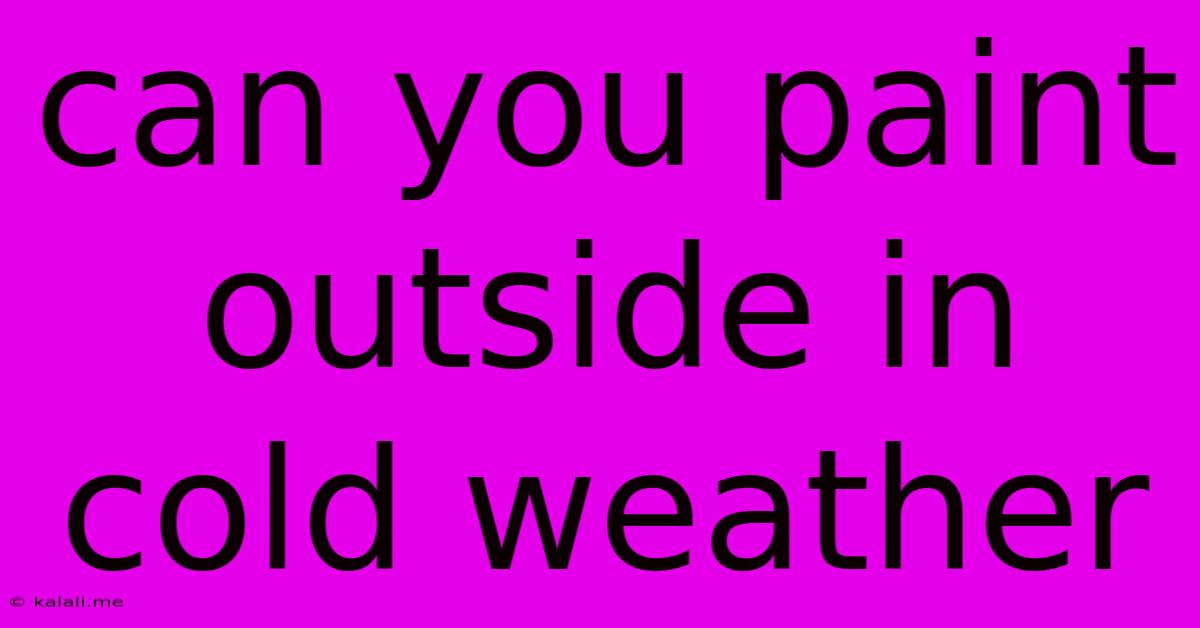Can You Paint Outside In Cold Weather
Kalali
Jun 09, 2025 · 4 min read

Table of Contents
Can You Paint Outside in Cold Weather? A Comprehensive Guide
Meta Description: Painting outdoors in cold weather presents unique challenges. This guide explores the impact of cold temperatures on paint, preparation, and application techniques, helping you decide if and how to paint in the cold.
Winter's icy grip can put a damper on many outdoor projects, including painting. The question, "Can you paint outside in cold weather?" isn't a simple yes or no. While it's certainly possible, success depends on understanding the challenges and employing the right techniques. This comprehensive guide will delve into the factors that influence successful cold-weather painting, offering you practical advice to get the job done right.
Understanding the Challenges of Cold-Weather Painting
The biggest hurdle in cold-weather painting is the impact of low temperatures on paint. Most paints require a minimum temperature for proper adhesion and curing. Below this temperature, the paint may not dry properly, leading to several issues:
- Poor adhesion: The paint might peel or flake off the surface easily.
- Slow drying time: This significantly extends the project timeline and increases the risk of damage from rain, snow, or frost.
- Uneven finish: Cold temperatures can affect the paint's consistency, resulting in an uneven or blotchy finish.
- Reduced durability: The paint may not be as durable and resistant to weathering as it would be if applied in warmer temperatures.
Beyond the paint itself, other factors come into play:
- Surface temperature: The surface you're painting must also be above the minimum temperature specified by the paint manufacturer. A cold surface will cool the paint down even further, hindering the curing process.
- Humidity: High humidity combined with cold temperatures can create condensation, which can interfere with paint adhesion and lead to mildew growth.
- Wind: Strong winds can chill the paint and the surface, slowing down drying and potentially leading to uneven application.
Choosing the Right Paint for Cold Weather
Not all paints are created equal when it comes to cold-weather application. Look for paints specifically formulated for low temperatures. These paints often contain additives that help them dry faster and adhere better in cold conditions. Always check the manufacturer's instructions for the recommended temperature range. Exterior paints generally have better cold-weather tolerance than interior paints.
Preparing for Cold-Weather Painting
Proper preparation is crucial for successful cold-weather painting. This includes:
- Checking the forecast: Avoid painting on days with freezing temperatures, rain, or high winds. Aim for a day with relatively mild temperatures and low humidity.
- Surface preparation: Clean and thoroughly dry the surface to be painted. Remove any loose paint, dirt, or debris. Ensure the surface is free of frost or ice.
- Warming the surface: If possible, gently warm the surface using a heater or heat lamp before applying the paint. This can help improve adhesion.
- Using a paint sprayer: In cold temperatures, using a paint sprayer can help prevent brush strokes and speed up the application process.
- Working in short bursts: This helps prevent the paint from getting too cold while you work.
- Using thin coats: Thick coats are more prone to issues in cold conditions. Multiple thin coats are preferable.
Post-Painting Considerations
Even with the right precautions, cold-weather painting requires extra care post-application:
- Allow ample drying time: The drying time will be significantly longer than in warmer conditions. Be patient and allow the paint to cure completely before exposing it to rain, snow, or extreme temperatures.
- Protect the painted surface: If possible, cover the freshly painted surface with a tarp or plastic sheeting to protect it from the elements.
- Monitor for issues: Regularly check the painted surface for signs of peeling, cracking, or other issues. If problems arise, address them immediately.
When to Avoid Cold-Weather Painting
While some cold-weather painting is feasible, there are times when it's best to postpone the project:
- Freezing temperatures: Avoid painting when temperatures are below freezing.
- High winds and rain: These conditions can compromise the paint's adhesion and drying process.
- Significant humidity: High humidity, especially combined with cold temperatures, can lead to condensation and paint failure.
Ultimately, painting outside in cold weather requires careful planning and execution. By understanding the challenges, selecting the appropriate materials, and following the right techniques, you can increase your chances of a successful outcome. However, if conditions are extremely unfavorable, delaying the project until warmer weather is often the best approach.
Latest Posts
Latest Posts
-
How To Make Foam Topping Commercial
Jun 10, 2025
-
Mtg Whenever You Gain Life Opponent Loses Life
Jun 10, 2025
-
What Stock Diameter For A 0 8 Barrel
Jun 10, 2025
-
My Company Never Asked For Laptop Back
Jun 10, 2025
-
Does The First Paragraph Have To Be Indented
Jun 10, 2025
Related Post
Thank you for visiting our website which covers about Can You Paint Outside In Cold Weather . We hope the information provided has been useful to you. Feel free to contact us if you have any questions or need further assistance. See you next time and don't miss to bookmark.